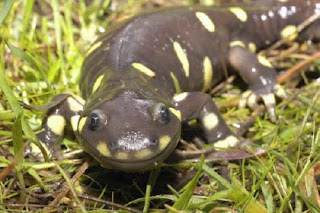 The media was abuzz this week with frog and fish-related stories. First came the news that the California Fish and Game Commission voted 3-2 to support the listing of the California tiger salamander as "threatened" under the California Endangered Species Act (Santa Rosa Press-Democrat story). Because this species is already federally-listed I don't think this will change the existing management significantly.
The media was abuzz this week with frog and fish-related stories. First came the news that the California Fish and Game Commission voted 3-2 to support the listing of the California tiger salamander as "threatened" under the California Endangered Species Act (Santa Rosa Press-Democrat story). Because this species is already federally-listed I don't think this will change the existing management significantly.
And then last Tuesday there was an excellent discussion about nonnative fish impacts on NPRs Diane Rehm show (archive available here). This show topic was prompted by the publication of the book, "An Entirely Synthetic Fish: How Rainbow Trout Beguiled America and Overran the World", by Anders Halverson. This is a must-read book that provides an exploration of the history, biology, and sociology of trout aquaculture and stocking. Anders was joined on the show by Curtis Milliron from the California Department of Fish and Game and Gerald Smith from the University of Michigan, and the three of them contributed to a lively discussion.
And finally, we had the publication of a new study by Tyrone Hayes (UC Berkeley), this one showing that exposure of frogs to low doses of the herbicide atrazine can result in complete feminization of males. The authors state, "Ten percent of the exposed genetic males developed into functional females that copulated with unexposed males and produced viable eggs." These results are remarkable and scary. If atrazine causes these bizarre effects in frogs, what effects does this stuff have on humans?
Back to The Mountain Yellow-legged Frog Site.
March 8, 2010
A Busy Week in the Media for California Amphibians and Fish
March 1, 2010
Lawsuit Update and Other Legal Intrigue
 In my last post I mentioned that in addition to the fish stocking lawsuits recently filed by the Center for Biological Diversity and the Owens Valley Committee I'd heard rumor of a third lawsuit. That rumor has now been substantiated. It was filed by Californians for Alternatives to Toxics, the Environmental Protection Information Center, Wilderness Watch, and Public Employees for Environmental Responsibility. Their petition focuses on many of the same issues covered by the other two petitions, including use of an improper objective, improper baseline against which impacts were evaluated, inadequate range of alternatives, and failure to adequately mitigate impacts of fish stocking. In addition, the petitioners argue that the practice of stocking fish into designated wilderness areas violates provisions of numerous laws related to wilderness.
In my last post I mentioned that in addition to the fish stocking lawsuits recently filed by the Center for Biological Diversity and the Owens Valley Committee I'd heard rumor of a third lawsuit. That rumor has now been substantiated. It was filed by Californians for Alternatives to Toxics, the Environmental Protection Information Center, Wilderness Watch, and Public Employees for Environmental Responsibility. Their petition focuses on many of the same issues covered by the other two petitions, including use of an improper objective, improper baseline against which impacts were evaluated, inadequate range of alternatives, and failure to adequately mitigate impacts of fish stocking. In addition, the petitioners argue that the practice of stocking fish into designated wilderness areas violates provisions of numerous laws related to wilderness.
On a somewhat different topic, on March 3 the California Fish and Game Commission is scheduled to vote on a petition to list the California Tiger Salamander as "threatened" under the state Endangered Species Act. This will be an interesting vote given its potential to put into place additional protections for this species, and also for what it will tell us about the likelihood that the Commission will vote to list the mountain yellow-legged frog under the California Endangered Species Act. The effort to list the California Tiger Salamander under the state Endangered Species Act is quite a twisted tale, with the Commission rejecting the original 2001 petition, rejecting a subsequent 2004 petition, this decision being overturned by the Sacramento Superior Court, the Commission appealing the court's decision, and the 2008 decision by the Third District of the California Court of Appeals upholding the original Superior Court decision. Now, almost 10 years after the original petition was filed, the Department of Fish and Game is recommending to the Commission that the species be listed as "threatened". For more information on this issue, click here.
The information upon which the latest petition is based is essentially unchanged over the decade since the original petition was filed, so why all of the legal contortions to prevent the listing? Delaying the inevitable seems to be the name of the game. It doesn't make for good policy, but it does make for good politics for those whose sympathies lie more with unbridled economic development than with the fate of this inconspicuous salamander that spends its life in and around vernal pools in California's grasslands.
Back to The Mountain Yellow-legged Frog Site.


